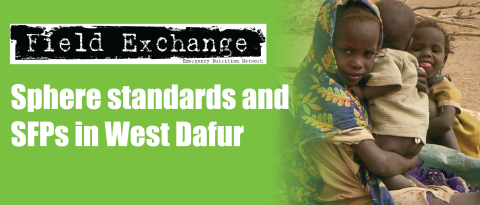Community based approaches to managing severe malnutrition: case study from Ethiopia
Summary of report1

A mother attends the CTC programme
A recent published paper describes Save the Children US's (SC US) experience of setting up a community therapeutic care (CTC) programme in the Southern Nations, Nationalities and Peoples Region (SNNPR), Ethiopia, following a drought in the lowlands of the region in 2003. The emergence of the problem was identified through the Disaster Prevention and Preparedness Commission (DPPC) regional early warning system. In response, SC US implemented programmes to provide emergency health and nutrition support to three adjacent woredas. They began by opening 16 therapeutic feeding centres that were often rudimentary tent structures adjacent to existing health centres and were intended to bring critical services to communities who were distant from hospitals. Because of the gravity of the problems, the increased need for nutritional response in the region, and the emerging literature that CTC offered comparable success rates with lower per-patient costs and greater coverage, SC US, technically assisted by Valid International, proposed a pilot CTC approach in one woreda to supplement the TFCs. This was eventually expanded into three woredas.
The first essential step was to enlist the cooperation and participation of local people. SC US used a participatory planning process in which local woreda officials, traditional birth attendants (TBAs), local volunteer community health workers, community-based reproductive health agents and other local officials were invited to a meeting to discuss the problems of malnutrition in their area and strategies that might be used to address these problems. SC US staff then identified local outreach workers to assist in the CTC process.
By mid-September 2003, the first CTC programme was functioning. Each of the programmes had several components;
- A stabilisation centre
- Outpatient therapeutic programme (OTP) for severely malnourished children with no significant medical complications, good appetite and only minor oedema
- A supplementary feeding programme (SFP) for children with moderate malnutrition and for pregnant or lactating women
- Health and nutrition education
- An outreach programme to follow up vulnerable cases in the home and community based screenings and community mobilisation activities.
By the 16th week of operations, in one woreda for which reliable data are available (Arbegona), 66% of severely malnourished children had been sufficiently rehabilitated to graduate to less intensive supplementary feeding. Eight-eight per cent of all admissions were discharged having attained an adequate weight for height and only 8.9% needed referral to a medical facility. Default rates were low (2.3%) and less than 1% died. Survey results during and after the emergency phase showed a marked reduction in mortality of children under five years. In September 2003, the daily under-five mortality rate was 1.47/10,000 and the rate of severe acute malnutrition was 1%. By March 2004, these rates had improved to 0.45/10,000 and 0.6%, respectively.
The SC US programme admitted 5,799 severely malnourished children over a five month period, 3,765 of whom progressed to supplementary feeding. An additional 7,961 were directly admitted to supplementary feeding. The default rate was low, indicating community acceptance of the approach. A coverage survey in Hulla and Arbegona districts found OTP coverage of 78.3% with SFP coverage of 86.8%. This compares very favourably with the SPHERE Project guidelines, which target rural coverage rates at more than 50%.

A child with RUTF enrolled in the CTC programme
Participation by the beneficiary communities was robust. Local officials participated in the planning and implementation of the programme from the outset, from organising distribution centres to encouraging their community members to participate. Regional and zonal health officials understood the importance of improved coverage and therefore allowed the CTC programme to be piloted. Community leaders and people with influence in the local community participated in the initial discussions and helped identify the communities to be targeted. Outreach workers were recruited from the communities that they served and were thus able to overcome any reluctance to acknowledge the declining nutritional status of children. Twice monthly food ration distributions and anthropometric assessments were performed in highly public settings ensuring transparency in the process. Local service providers - TBAs and reproductive health agents - received additional training that may improve their effectiveness in service delivery in the long term.
Because of the strong emphasis on community management of problems, CTC programming provides an ideal opportunity to bridge the divide between relief and development. The issues that remain in SNNPR are many and diverse: water and sanitation systems are inadequate, high birth-rates and small landholdings exacerbate population pressures, poor health infrastructure makes primary health care delivery problematic, and low agricultural productivity in relation to population size makes chronic food insecurity and periodic emergencies inevitable. These are all problems that development programmes can address. SC US believes that the positive community involvement that the CTC programme has fostered is a sound foundation for the implementation of participatory development strategies, as part of a comprehensive development programme.
1 Chaiken. S, Deconinck H and Degefie T (2006). The promise of a community-based approach to managing severe malnutrition: A case study from Ethiopia. Food and Nutrition Bulletin, vol 27, pp 95-104.
Imported from FEX website


 English
English Français
Français Deutsch
Deutsch Italiano
Italiano Español
Español